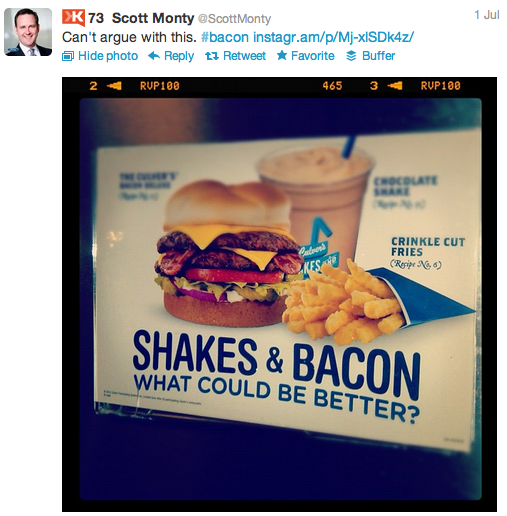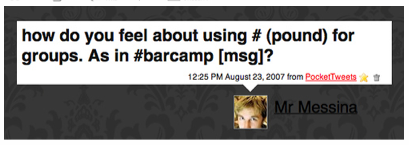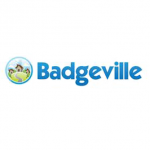 My colleagues at Ant’s Eye View have submitted more sessions than ever before and we need your support to be selected to present at SXSW Interactive 2013. With over 3,000 sessions submitted for all of SXSW this year, the competition is stiff, so your votes of Thumbs Up and Comments on our Session Abstracts in the SXSW Panel Picker can help make the difference on whether the social sessions submitted by Ants will make the cut.
My colleagues at Ant’s Eye View have submitted more sessions than ever before and we need your support to be selected to present at SXSW Interactive 2013. With over 3,000 sessions submitted for all of SXSW this year, the competition is stiff, so your votes of Thumbs Up and Comments on our Session Abstracts in the SXSW Panel Picker can help make the difference on whether the social sessions submitted by Ants will make the cut.
Here’s the Ant Lineup, many of them back by popular demand from this year’s SXSW Interactive:
1. Mosh Pit of Experts: The Future of Social featuring SVP, Sean McDonald
Description: Enough of the pontificating panel! In a rapid and fast paced (gameshow-like) session, we put the audience (that means YOU) in the hot seat as the expert on the future of social. How will social integrate into functional responsibilities? What kind of tools will need to evolve? How will the big players in the industry evolve? Where will innovation come from? We’ve done this before and the insights from brands, agencies, and consultants are fascinating. You will be cheered and revered by your fellow audience members (or not). Fun and insightful, this session promises more help in preparing for the future of social than anything in your future!2. Two Weeks At A Time: A Marketing Transformation featuring SVP, Todd Shimizu
Description: Today’s marketer must challenge the status quo of campaign marketing. Digital storytelling and social engagement have turned marketing on its head and present incredible opportunities for innovation and creativity. This new energy is unleashing a transformation across marketing; marketers are starting to attack problems and measure their successes, literally, two weeks at a time with Agile Marketing. And in doing, they’re improving their velocity, precision, flexibility, and team morale. We will show how Agile development enables organizations “to build an uncertain product, for an uncertain customer, in an uncertain market.” For example, Cisco saw their first agile project deliver a comprehensive mobile advertising dashboard in one 2 week sprint, after months of inertia previously. Discover how Agile can be your blueprint for marketing transformation.3. Social Media Against Humanity featuring Vice-President, Christopher Carfi
Description: Social Media Against Humanity is a celebration of remix culture, social media, snark and slightly embarrassed self-loathing. We’ve remixed the social card game Cards Against Humanity (CAH), adding SXSW and social media elements. After a brief setup and explanation, all participants in the session will compete in a competition bracket of four 15-minute rounds of the SXSW-remixed version of the CAH card game. Based on the number of participants in the session, we will break into groups and each group will play a round of CAH. The winners from each group will move on to the next round, and we will repeat this process until a winner is chosen. Participants who are eliminated in the early rounds will be encouraged to watch, mock and heckle those still in the game.*(* footnote: This session is not associated with Cards Against Humanity LLC, and we are using the CAH concept under a Creative Commons BY-NC-SA 2.0 license. You can learn more about the source material at http://cardsagainsthumanity.com)
4. Tricks of the Trade: Grow Unity in Your Community featuring Director, Kat Mandelstein
Description: Community management is an art, not a science. To a degree, there is really no program out there to help you adequately learn all of the skills needed. Successful community leaders are part therapist, part den mother, part coach, part referee. But at the end of the day, running a thriving online community is not about U! For a community to grow and thrive, it is all about activating and strengthening the unity of the community members. When you get the culture right, it is truly magical. Learn from a panel who has been perfecting this craft for years in some of the most successful B-to-C, B-to-B and non-profit organizations. And because community is all about collaboration, we invite you to contribute your best practices and biggest challenges during the open mic jam at the end of this session. We promise, this is one session that you won’t leave empty handed. All attendees in this session will receive their very own Community Management Bag-o-tricks.5. Now or Never: Leading “Social” Business Change featuring Sr. Consultant,Anthony Garcia
Description: This moderated session will showcase three large enterprise companies – IBM, Walmart Canada, and 3M, all of which are embarking on real social business transformations. These world-class brands offer you an up close and personal view from the frontlines of driving an internal culture of social across multiple geographies, business units, and functional areas. It’s NOW or NEVER for you to go out and LEAD that change. Our panel of practitioners will share how they are integrating social into their brands, processes, and daily behavior. They will attest to the bumps and bruises along the way, and share some of the secret sauce. How can you overcome resistance? What’s the most effective way to align your leadership to an internal social program? How do you measure the impact of being social on your business? Listen and discuss with our panel as they share how becoming a social business engages employees to be productive, collaborative and smarter inside the enterprise.6. Hey Nonprofits, You Better Innovate or Die! featuring Sr. Consultant, David J. Neff
Description: Welcome to the new normal: Soft global economics and increased needs. Demand has never outpaced supply on such a scale in the nonprofit community. It is time for a renaissance fueled by a culture of innovation driven by nonprofit leadership. Innovation in Technology shall become the new culture, mantra, and driving force in the coming decades. So where do you begin? Join us for a panel conversation with leading innovation advocates and nonprofit leaders who will share technical details on building a culture of innovation, and reaping the rewards. Hear case examples of how to find innovative ideas, develop them, and maximize the value of every employee … before it is too late!7. Meetup: Social Scientists Unite! featuring Sr. Consultant, Sam Eder
Description: Social scientist of SXSW Interactive unite! As digital interactions start to challenge the primacy of traditional activities such as shopping, chatting with friends, and working businesses have increasingly turned to social scientists to understand current and future behavior on the web. This meet up is for practitioners, academics, and aficionados of the social sciences in how it applies to those digital interactions. Let’s discuss the current role of social science in digital, share best practices, and findings of interest.
Thanks in advance for your support!















